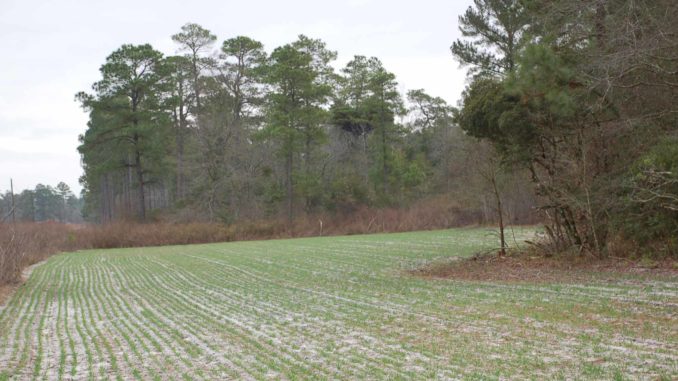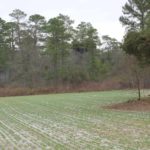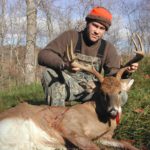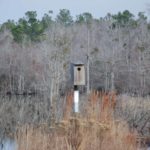
more heavily-grazed winter food plots
With winter arriving this month, the bountiful natural foods of fall begin to dwindle. Deer and other wildlife consume the remaining acorns and start seeking out alternative food sources. The cool-season food plot offers nutrition to last through the fall and sometimes well into the winter, depending on the seed mix. While each food-plot seed tolerates winter conditions differently, some plants easily withstand them. Cold-tolerable food plots will welcome a round of nutrient enrichment this month.
Wildlife foods are important throughout the year, but winter foods are among the most important because they are available during a time when natural foods become uncommon. Deer coming off the laborious breeding season need an energy-rich food source to rebuild their body mass. Newly-impregnated does need nutritious meals regularly to provide their embryos crucial nutrition for healthy development. Even though the Carolinas are still considered the South, extended periods of freezing temperatures are common. Deer and other wildlife must keep their bellies full over the winter to fuel their metabolisms and stay warm.
Without a doubt, the forested and successional regions of the Carolinas produce a wide variety of natural browse, including leaves, needles, buds, and twigs. While these natural foods contain energy, their palatability, nutrient content, and likeness are far from preferred. Deer and other wildlife struggle to survive on marginal food sources available in winter. Wildlife will seek out and make homes near the best food sources available in the area. A well-kept food plot full of tasty treats is a real Christmas present for wandering wildlife that detect its location, allowing them to triumph over winter conditions.
Out of all the food-plot seeds available, very few lack proper nutrition and palatability. However, some crops deteriorate quickly from maturation and heavy browsing. Basically, some food-plot seeds are more or less tolerable of browsing than others. Oats, wheat and rye are great winter foods tolerable of heavy browsing. These cool-season plots begin serving lunch just as the tender young plants erupt through the soil’s surface.
Heavy browsing will invigorate growth of the clipped terminal tissue, but constant pressure on these food plots will deplete the fertility of the soils down beneath. Cool-season plots of oats, wheat and rye can benefit from nutrient enrichment. Even though phosphorus and potash are important for the growth of these crops, these nutrients will sustain within the soil from planting. Nitrogen can be depleted quickly in areas experiencing heavy browsing, and it is a necessary nutrient for growth of wheat, oats, and rye. A top dressing of nitrogen in December or January will activate and invigorate extra growth from these crops. Depending on the level of grazing, an application of 30 to 50 pounds per acre of nitrogen can be applied during mild weather and periods of normal rainfall.
Get duck boxes ready
The wood duck is among the most attractive and most plentiful ducks available for hunters in the Carolinas. While some wood ducks migrate in from other states, we have a substantial resident population referred by man local hunters as “summer ducks.” In the wild, wood ducks construct their nests in dead snags near water, but they will readily-use wooden boxes erected above the ground. With the nesting season just around the corner, duck boxes should be erected, and existing boxes should be cleaned out in time to welcome nesting hens to the area.
Even though Mother Nature provides natural nests for wood ducks, their availability is poor. Duck boxes are proven to increase hatching and survival of wood ducks, an obviously positive effect on the regional wood duck population. New boxes should be erected above water or within 50 yards of standing water to capture a hen’s attention during the nesting season.
While building and erecting enough duck boxes is important, seasonal maintenance of existing boxes is just as crucial. Proper maintenance will ensure the nest’s viability. Annual maintenance should be completed during early fall and winter, but no later than January to allow for the highest chance for the wood ducks using the boxes.
Old shavings, egg shell material and foreign debris should be removed and replaced with new bedding material. Duck nests are prime targets for pesky predators, including snakes and raccoons. Predator guards are preferred and engineered to prevent uninvited guests from entering the nest. Predator guards should be inspected and repaired if necessary to prevent nests from being disturbed.
Keep quail behind bars
Quail season is well underway, and while the population of the South’s favorite gamebird remains low as compared to the historic numbers, sustainable wild populations thrive in areas with adequate habitat and controlled harvest. Even though numbers may be low, hunters and wildlife managers should restrain from releasing pen-raised birds to supplement their native population.
Commercial quail-hunting preserves around the Carolinas routinely purchase and release quail to be immediately-harvested. While these controlled hunts harvest the majority of their released birds, over time, some birds escape after each release into the wild. These pen-raised birds lack survival instincts and become a quick meal for the local avian and 4-legged predators in the area. In fact, these commercial hunting preserves attract predators from adjoining lands to take part in the carnage of the escapees. But they also will take out their fair share of native birds and small mammals. Hawks, foxes, bobcats, and coyotes become aware of the bumper food source and move into the area to feed.
Not only does releasing pen-raised birds increase predator awareness, these birds transmit diseases and parasites to wild birds, causing massive mortality among native flocks. Increased production of pen-raised birds and disease control methods of commercial flocks has created additional strains of these harmful micro-organisms potentially-causing more damage to native populations.
Wildlife managers and hunters should refrain from releasing pen-raised birds on their property. Instead, habitat management/manipulation techniques, such as prescribed fire, plantings, reduced mowing, and others should be incorporated to increase preferred accommodations and concessions preferred by bobwhite quail.







Be the first to comment